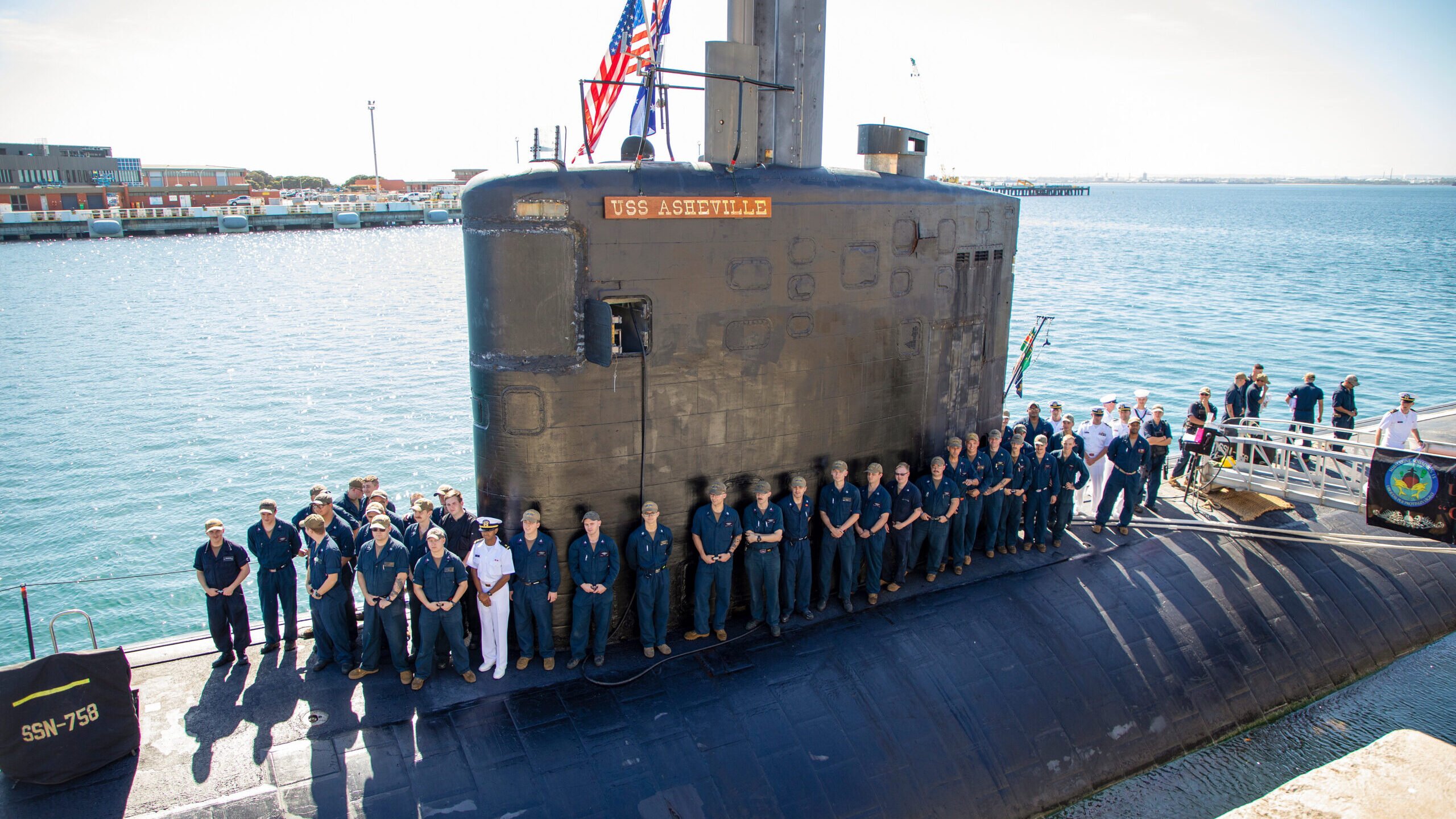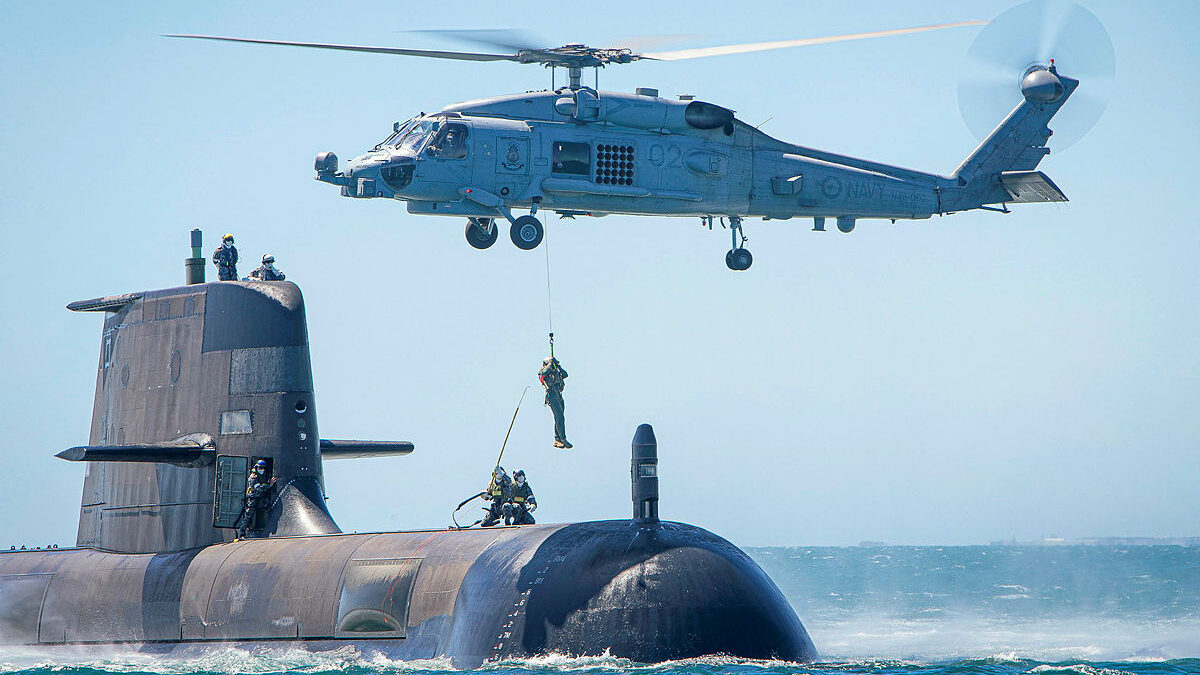
The crew of the USS Asheville assemble on the casing of the submarine during a visit to HMAS Stirling in Rockingham, Western Australia. (Australian government)
CORRECTION 4/18/2023 at 11:50am ET: The original story misstated a comment from Sidharth Kaushal concerning Astute class submarines hosting vertical launch systems (VLS). He said that the Astute class successor design (SSNR) will have VLS compatibility. This has been corrected.
BELFAST — The recently revealed AUKUS plan, including the development of new SSN AUKUS-class submarines, clearly changes the strategic calculus for the United States, United Kingdom and Australia in the Indo-Pacific. What is less clear, naval analysts tell Breaking Defense, is exactly what impact it will have on China’s thinking — especially when it comes to a potential invasion of Taiwan.
China has vowed to “reunify” with Taiwan in defiance of international opposition to such a move and continues to be regarded by the US as its main “pacing challenge,” or in the case of the newly released UK Integrated Review Refresh, “an epoch-defining challenge.”
Hence, while political leaders have been careful to say AUKUS isn’t about China specifically, it’s no surprise that the deal — covering plans to sell Australia three US Navy Virginia-class subs in the early 2030s, with a new UK based nuclear sub design entering UK service in the late 2030s and Australian service in the early 2040s — has been viewed through the lens of a potential conflict with Beijing. And in that sense, experts see potential.
Fundamentally, the reason behind Australia opting to embrace the SSN AUKUS design and the expanded partnership with the US and UK is based on an assessment of future military challenges and threats, and a need to “have a submarine that is survivable enough and capable of fast deployments,” said Nick Childs, senior fellow for naval forces and maritime security at the International Institute for Strategic Studies (IISS), a UK-based defense and security thinktank.
“In terms of a full-on maritime confrontation between peer competitors and especially when talking about China, one of the most survivable capabilities that will allow you to operate in a contested environment is subsurface assets, particularly nuclear powered submarines,” he added. “As the new agreement offers a greater pool of nuclear powered submarines, among a wider pool of operators in the future, not just the US but Australia, and at least a small commitment from the UK to deploy forward in the [Indo-Pacific] region, that must provide some food for thought for military planners in Beijing.”
What kind of second-guessing that could impose on planners in China is unclear, analysts said, even as they all agree China will have to take the new AUKUS plan into account. And the first move will, it seems, be a political one.
“We’re already seeing China’s response. They criticize Australia for doing it, criticize us,” Harry Harris, a retired US Navy admiral who led US Pacific Command and later served as ambassador to South Korea, told Breaking Defense. “We’ll see their pressure campaign increase on countries like Australia and others who share our values…. And we’ll see them ratchet up that pressure.
“At the end of the day we are in a far stronger position because we have allies and partners,” Harris said, “and it It shows just how weak the PRC is in terms of their ability to rely on others and help them in their time of need.”
Even though the SSN AUKUS subs are not slated to come online for Australia until the early 2040s, Harris pointed out that the basing of US subs in Australian ports and the addition of Virginia-class subs to Australia’s arsenal will have a more near-term impact. “This is not something that’s going to happen just in the 2040s — there are parts of it that are already happening,” Harris said.
The Taiwan Impact
So much of what happens in the Indo-Pacific revolves around the question of if and when China will try to invade Taiwan. AUKUS is no different — and it is telling that Richard Marles, the Australian defense minister, specified this weekend that there is no commitment on behalf of Canberra to support a US defense of Taiwan.
“Of course not, and nor was one sought,” he told The Telegraph Sunday, when asked if the terms of the optimal pathway agreement had been brokered around Australia offering a commitment to the US in return for the deal being signed.
Even with the additional basing aspects to the AUKUS deal, the fact SSN AUKUS won’t be active until the early 2040s means they would come online long after the much-ballyhooed “Davidson Window,” named after an estimation from former INDOPACOM head Adm. Phil Davidson, who suggested a 2027 timeframe for when China could move on Taiwan.
“His [Davidson’s] comments have kind of been abused over the last couple years as he was talking about China developing the capability to be able to invade by that point,” said Blake Herzinger, nonresident fellow at the American Enterprise Institute think tank.
RELATED: ‘A bloody mess’ with ‘terrible loss of life’: How a China-US conflict over Taiwan could play out
“China is not going to resort to violence immediately if there are other options available, as an attack would be enormously destructive for everyone, probably most so Beijing. Their losses militarily and economically would be incredible.”
In Harris’ mind, the specifics of AUKUS’ impact on Beijing’s thinking on Taiwan isn’t clear. “I don’t know how it’ll impact Taiwan. I trust it’ll have a deterrent effect,” Harris said.
But Sidharth Kaushal, research fellow at the UK-based Royal United Services Institute defense think tank, was more bullish on the deal’s impact, saying AUKUS will likely make a Chinese attack on Taiwan, “decidedly less appealing.”
Specifically, the SSN AUKUS subs, based on the UK Submersible Ship Nuclear Replacement (SSNR) concept and due to replace Royal Navy Astute-Class SSN’s, would make China vulnerable to attacks on “critical amphibious platforms,” even in a scenario where Beijing successfully held US surface assets at range through Anti-Access/Area Denial (A2/AD) capabilities, explained Kaushal.

Royal Australian Navy Collins-class submarines are set to be replaced in the 2040’s by a UK designed SSN AUKUS fleet. (Australia DoD)
Set to be integrated with “the best of submarine technology” the US, UK and Australia has to offer, the full range of SSN AUKUS subsystems and weapons have still to be disclosed by defense officials. Kaushal suggested that if the subs are designed with provision for hypersonic weapon launches, they would offer, an “inland deep strike capability,” the like of which few other US services or international partners can currently provide outside of strategic bombers.
“That type of capability could be very useful from a targeting perspective, in terms of engaging command nodes or other bits of military hardware if they were identified on a prompt [strike] basis,” he added.
The idea that hypersonic missiles could be fitted to SSN AUKUS vessels looks realistic, in Kaushal’s estimation, because vertical launch cell systems are part of the SSNR design and the Virginia-class, while the overall size of the new subs would allow “quite a few” of the weapons to be carried. Such a selection is also likely to be influenced by stealth characteristics offered by the missiles and their “relatively survivable” profile.
Though there is still much to determine relating to the SSN AUKUS design, PLAN subsurface capabilities offer the trilateral alliance cause for optimism. China’s “reconnaissance strike complex” has been designed to put enemy surface vessels at “risk” through the networking of satellites and airborne sensors, supported by the DF-21D antiship ballistic missile enabling long range strikes, out to a range of 2,000Km, but its antisubmarine warfare (ASW) capabilities are much less formidable, added Kaushal.
He suggested that China’s lack of joint exercises incorporating ASW activities has held it back, while the inadequate noise profile of the Type 93 nuclear-powered attack submarine adds to a subsea capability set inferior to the US and her allies.
“It’s an area where the US still enjoys a decisive advantage,” said Kaushal.
Harris said that China is well aware of the need for greater ASW capabilities. “I expect them to try and increase [ASW], but I expect them to do that regardless” of the new AUKUS details, he said. “I do think this gives them some impetus, but they can only go so far.”
And like Kaushal, Harris says this is an area where the US has a clear advantage right now. “Antisubmarine warfare is both an art and a science. The United States and UK have been at it since, really, World War 1, and certainly throughout the entire Cold War. Australia has been with us also,” he noted.
China’s subsurface capabilities are set to improve long term however, with a total of 70-75 submarines, up from a current fleet of around 65-66 vessels, due to be constructed and enter service over the next ten years, noted Herzinger.
All that said, he noted that predicting the outcome of a future war is problematic because of complications related to international obligations.
“We’re dealing with some hypotheticals regarding military balance issues [in the Indo-Pacific], because there aren’t any states that have a treaty obligation to immediately get involved in the defense of Taiwan,” Herzinger added.
While a “deterrence balance” might not be impacted by the optimal pathway agreement in light of the new subs still to arrive, near term military balance implications could be much more profound on the basis that nations holding a vested interest in “maintaining the status quo” across the Indo-Pacific region will grow in confidence that the undersea capability advantage over China continues to be reinforced, according to Herzinger.
Colin Clark in Sydney contributed to this report.






















